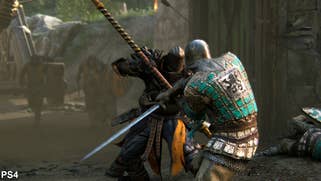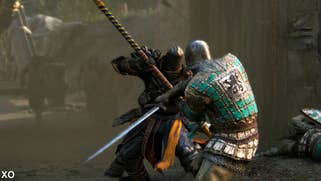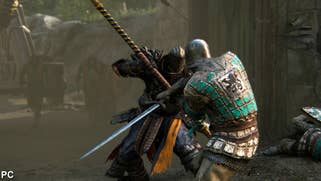Face-Off: For Honor
Great on console, but the 60fps PC experience is a cut above.
As console comparisons go, a Face-Off between PS4 and Xbox One versions of For Honor would be pointless to an almost spectacular degree. In every way that matters, these two versions of the game are essentially identical - to a degree we've not seen for some time. We'll cover off the details of that, but there is a game-changing experience amongst the For Honor line-up. It's not PS4 Pro - although Ubisoft has done a great job here - but rather the PC release. For Honor is a superb fighting game, but it's pegged to 30fps. On PC, the sky's the limit.
On the face of it, For Honor does indeed look like some kind of hybrid of the Dark Souls games, merged with crowd-level brawling of Dynasty Warriors with additional, MOBA-like overtones. But as Wes pointed out in his impressions piece, it's better to think of For Honor as a third-person Soul Calibur.
And with that in mind, there's a certain air of frustration and uncertainty around the control mechanics of the game. There is weight and heft to the weaponry, which almost feels like an overly intrusive amount of input lag. But it isn't really - the game is designed like this. It's intrinsic to the mechanics, but the difference with the PC version is that running the game at 60fps serves to remove the doubt. There's a reason that fighting games are usually designed to refresh in line with a 60Hz monitor - it's to ensure a low latency interface, and crisp response.
As a result, the boost in frame-rate helps to make countering and performing more complex moves feel more natural, you feel more in control. Responding to enemy attacks feels more intuitive, and the gameplay overall just feels more balanced. Building a reasonably powerful gaming PC allows us to go beyond the console experience, removing the compromises inherent in designing for a low-price box. But fundamentally, the games we play are tailored specifically for those devices, so PC gameplay only rarely offers up a revelatory improvement. For Honor is one of those infrequent titles that truly benefits at a fundamental level from the ability to scale up performance.
But what's clear from the visual ambition of the game is that For Honor could never really target that all-important 60fps on console. Ubisoft has crafted a title designed to look beautiful. Geometry levels are intense, texture detail is intricate, and the developers have doubled down on CPU-intensive aspects such as animation and enemy count. There's a sense that the developers have actually doubled down on 30fps - For Honor operates with an advanced post-process pipeline that would require a lot of work to run at 60Hz. Anti-aliasing seems to be post-process and temporal in nature, with the one difference we saw between PS4 and Xbox One coming down to some strange variations in edge detail in still shots - perhaps suggesting a lower level of temporal accumulation on the Microsoft platform.
However, in motion, it's virtually impossible to tell the two console versions of the game apart. The detail level is the same, texture detail is identical and even taxing GPU effects such as shadow resolution, depth of field and draw distance are entirely like-for-like. Even with (what we suspect to be) variances in temporal accumulation, the end result is still a nigh-on identical 1080p presention on both consoles.
Of course, the PC version allows us to push on with further refinements, but certainly at our chosen resolution of 1080p, there is a clear case of diminishing returns here. Ubisoft has balanced the core art design against the capabilities of the consoles, meaning that genuine game-changing visual improvements are limited. Of course, there are boosts in the usual departments - higher quality shadows and improved ambient occlusion, for example. But the point is that these elements look perfectly fine on consoles. One clear, unambiguous area of improvement comes from reflections - significantly improved on PC.
























It's a similar situation with the improved geometry levels and enhanced draw distance seen on PC. It's nice to have, of course, but it's still a case of additional refinement as opposed to a game-changing improvement to the core aesthetic. Texture quality also sees noticeable improvement - especially noticeable in cutscenes on character close-ups - but in common with the title's other enhancements, we suspect that moving up to 1440p and 4K resolutions will see these improvements have more of an impact.
All of which brings us on to the enhancements Ubisoft has come up with for PlayStation 4 Pro, which is designed to look great on a 4K screen, even if native ultra HD is not delivered. We've only looked at the open beta version so far, but the implementation is so impressive, we doubt the developer would have improved it (we aim to return to this early next week). The bottom line is that, curiously, pixel-counting only resolves a native 2560x1440 framebuffer.
However, image quality is not defined by pixel count alone and For Honor looks sensational on Pro - the level of detail resolved and the lack of 'jaggies' is self-evident. Temporal super-sampling applied to the native framebuffer image is doing a superb job here and it's going to be fascinating to compare the results here to the actual native 4K output from the PC version of the game. The PS4 Pro version also seems to deploy a more comprehensive ambient occlusion solution too - not a game-changer, but again, nice to have.
Performance is also rock-solid on all console versions of the game. Ubisoft may not have been able to provide a 60fps experience on consoles, but the 30fps line in our performance testing never wavers where it matters - in the gameplay. PS4 Pro is even more solid, based on our open beta testing. For the PC owner looking to enjoy all the visual embellishments and the bump to 60fps, GTX 1060 or RX 480 will both take you where need to go. Nvidia's card runs with a small advantage in the 2-5fps area and in stress tests, the RX 480 can dip beneath the 60fps threshold (albeit infrequently). That said, there's tweakability and scalability here and little to lose visually by dropping back certain settings - shadows and ambient occlusion quality, for starters.
In conclusion, it goes without saying that this title is recommended across platforms, for all the reasons mentioned in the Eurogamer For Honor review. Well optimised and balanced across PS4, Pro and Xbox One, everyone's a winner here. Xbox One and PS4 are effectively interchangeable, but for those with 4K screens, PlayStation 4 Pro is the obvious way to go - it may not offer a native ultra HD presentation, but the temporal super-sampling and upscaling techniques combine to produce a great presentation.
But it's the PC version that proves most fascinating here, and ultimately, it's the version of For Honor that offers genuine improvements that go beyond the cosmetic. There's a reason why gamers covet 60fps gameplay: the silky-smooth visuals of course, along with input lag savings that usually start at 50ms below the console equivalents. The additional temporal resolution seems to offer a crisper experience in the controls and in a game where timing in both attack and defence is so fundamental, For Honor simply feels better to play.
At 1080p at least, the visual refinements are the final flourish - as opposed to a game-changing improvement - but we're curious to see whether the impact of the enhancements scales in line with resolution, something we'll be testing alongside the final PS4 Pro version in the immediate future.










